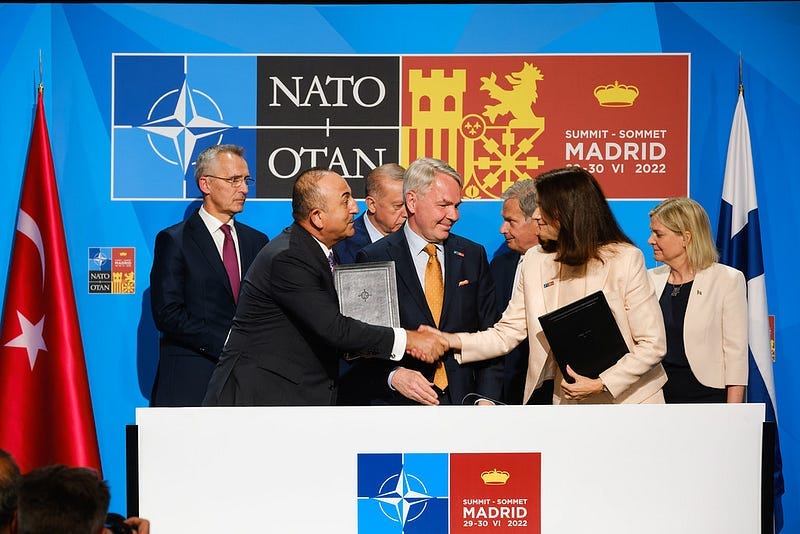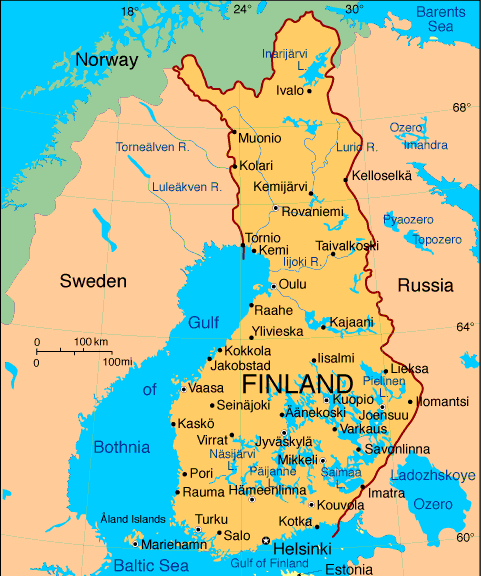Finland Joins NATO and Defies Russia
The War in Ukraine is Degrading Russian Security Interest
The War in Ukraine is Degrading Russian Security
In another display of Russian president Vladimir Putin’s military and strategic genius, a country that has maintained neutrality since World War II, Finland, has joined NATO. Things could not be going better for the Russian leader.

On April 4th, Finland officially became the 31st member nation of NATO. This is the culmination of a massive shift of public and elite opinion in Finland due to Russia’s invasion of Ukraine. Having fought its own war against the Soviet Union in 1940, known as the Winter War, there was no doubt that Finns would view a Russian tyrant’s unprovoked aggression as a grave threat. And now, the 823-mile border between Finland and Russia is secured by NATO firepower.
A Powerful Military Enhances NATO
NATO commander Jens Stoltenberg and Finnish President Sauli Niinistö both welcomed the news. The addition of Finland to NATO is perhaps the most consequential change to the European security architecture since the 1999 accession of the first former Warsaw Pact nations. For a country with a population of barely over 5 million, Finland arguably boasts the most powerful military in Europe pound-for-pound.
Finland is one of the few European nations with military conscription; all Finnish citizens must perform a year of military service before they turn 30. These conscripts, if they are between 17 and 60, become members of the army reserve, with exceptions. This means nearly 16% of Finns are members of the reserve force. Even NBA star Lauri Markkanen must serve.
Finland also boasts arguably Western Europe’s most powerful artillery, with 700 howitzers and cannons, 100 rocket launders, and 700 mortars. It also boasts an Israeli missile and battery defense system and is investing in advanced air defense, including high altitude. In addition, Finland has a significant drone fleet and enough winter equipment and firearms for its entire army reserve. Finally, the Finnish Air Force is about to have its 61 fighter jets replaced with 64 F-35 jets, with delivery expected in 2026.
Finland is no pushover, and its addition to NATO is a net gain to its defense capabilities. Russia would have a much more difficult time overrunning Finnish territory than Ukrainian territory, due to Finland’s arsenal, army, and its extensive network of defenses and bunkers constructed after the Winter War, to which it’s adding a border wall.
There will likely be some sort of response from Russia. The accession of Finland to NATO and the prospective accession of Sweden represent a major degradation of Russia’s strategic position in Europe.
An Encircled Economy
Russia’s only two outlets to the sea that are clear year-round are through the Baltic Sea and the Black Sea. The Black Sea route requires Russian vessels to transit waters surrounded by NATO countries, particularly Greece and Turkey. Even if Russia manages to hold on to its gains on Ukraine’s Black Sea coast and can freely access the Black Sea, it will still need to rely on routes lined by members of a hostile alliance.
Those strategic gains are more than offset by Sweden and Finland joining NATO. The Finnish mainland is less than 100 miles from Russia’s second city and former imperial capital St Petersburg. Any ships leaving from here or the Russian exclave of Kaliningrad will need to traverse a Baltic Sea surrounded by NATO countries and transit the narrow strait between Sweden and Denmark.
This means Russia will have to look to the north to its Arctic ports or to the east and southeast over land-based Eurasian routes. This explains Russia reorienting its foreign policy to the east, and building economic ties with the Shanghai Cooperation Organization (SCO), including the states of Central Asia. Russia will have to rely on land-based routes through Iran, Central Asia, and China to bring its commodities to market year-round.
What about the Arctic? Well, Russia’s large Arctic port cities of Arkhangelsk and Murmansk are perilously close to Finland and Norway. And shipping must transit through either the NATO-surrounded North Sea or the Bering Strait, which has the United States on the other side, for Russian cargo to reach anywhere of value.
A Military Disaster
From a military perspective, Finland joining NATO creates a major vulnerability for Russian forces already stretched thin by the war in Ukraine and its other regional commitments. 823 miles of border requires a large military force in the range of tens of thousands to defend credibly, not to mention military vehicles, ammunition and weapons, and surveillance capabilities. Russia has none of these things to spare.
The Kola Peninsula, which borders Finland and hosts Russia’s Northern Fleet, is particularly vulnerable. It hosts surface-to-air cruise missiles designed to interdict in the case of a land war in northern Europe. It also hosts a fleet of nuclear submarines that provide a key deterrent to keep the vital North Sea route open.
Russians see Finnish and Swedish accession to NATO as a threat, with some officials vowing to take “appropriate military-technical measures”. Already, Russian defense minister Sergei Shoigu has announced the creation of an army corps in the Karelia region on the Finnish border, as well as the creation of military districts specifically for Moscow and St Petersburg.
The Ukraine invasion will prevent any major response. Russia is sourcing WWII-era tanks from warehouses to regenerate its forces. It has shifted troops out of the Nordic region and into Ukraine. Russia’s forces have sustained over 200,000 casualties, meaning their regular forces have been significantly defeated. Additional deployments require poorly trained conscripts and questionably maintained equipment.
The primary means Russia will have to defend its northern border, and its other borders in Asia and the Caucasus, is its nuclear deterrent. Without its stockpile of nuclear weapons inherited from the Soviet Union, Russia would have no ability to maintain its security. It’s what enables risky military adventures in places like Ukraine. But, once the war in Ukraine ends, expect Russia to prioritize the Nordic region.

What Does This Mean for Europe?
Finland's joining NATO will put pressure on the Russians to end the war in Ukraine so they can replenish their forces and direct them to Russia’s deteriorating security situation in the north. This will ultimately give more leverage to Ukraine in its inevitable negotiations with Russia and give more room to maneuver to countries like Georgia and Moldova that would like to remove the Russian military presence in their countries.
Even if Russia can’t respond immediately to NATO enlargement with its ground forces, it can use its other hybrid capabilities to make life more difficult for NATO allies. This includes stepped-up cyber-attacks and counter-intelligence efforts similar to what we saw with the recent leak of American top-secret intelligence. A coordinated response will be needed.
NATO needs to bolster its deterrence posture in the Nordic region to prepare for the future. This should include large-scale military exercises, greater regional command integration, and improving air defenses and surveillance and intelligence-gathering capabilities. NATO also needs to develop robust contingency planning to signal to the Russians that we are prepared for anything they might do.
Russia’s actions in Ukraine have provided an opening to stabilize regional security by pushing Sweden and Finland into NATO and degrading Russia’s military capabilities. We should be prepared for the future this will bring and capitalize on this once-in-a-generation opportunity.



